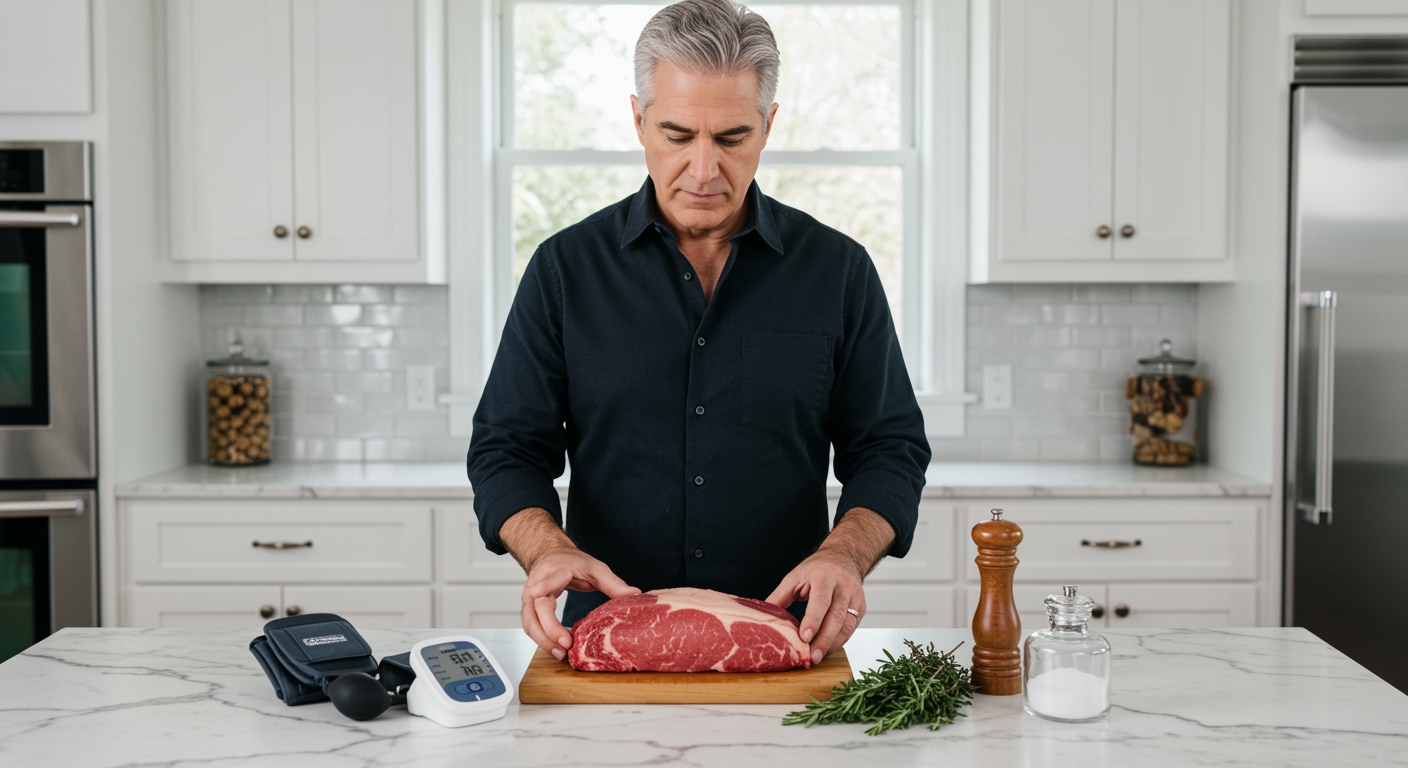✪ Key Takeaway: Steak itself does not directly raise blood pressure, but high sodium seasonings and overcooking create harmful compounds that can.
Introduction
Your doctor just told you to watch your blood pressure and now you are staring at that juicy steak wondering if it will send your numbers through the roof.
You might be asking this question because red meat has gotten a bad reputation for heart health, and you want to know if you need to give up one of your favorite foods forever.
Hi, I am Abdur, your nutrition coach and today I am going to explain exactly how steak affects your blood pressure and what you can do to enjoy it safely.
Does Steak Directly Raise Blood Pressure?
The protein in steak does not cause your blood pressure to spike on its own.
Your body breaks down the protein into amino acids, which actually help maintain healthy blood vessel function.
The real problem comes from what happens to the steak during preparation and cooking.
When you add high-sodium seasonings, marinades, or sauces, you dramatically increase the sodium content of your meal.
Excess sodium causes your kidneys to retain more water, which increases blood volume and puts extra pressure on your artery walls.
A plain grilled steak contains only about 60 milligrams of natural sodium, but restaurant preparations can add 1000 milligrams or more.
✪ Fact: A 6-ounce plain steak has less sodium than two slices of bread.
How Does Cooking Method Impact Blood Pressure?
The way you cook your steak creates different compounds that can affect your cardiovascular system.
High-temperature cooking methods like grilling, broiling, or pan-frying at very high heat produce advanced glycation end products called AGEs.
These AGEs promote inflammation in your blood vessels and can contribute to arterial stiffness over time.
Research shows that people who regularly eat well-done meat have higher blood pressure readings compared to those who eat medium-rare preparations.
The charred, blackened parts of overcooked steak contain the highest concentrations of these harmful compounds.
Lower temperature cooking methods like braising, slow roasting, or sous vide produce fewer AGEs while keeping the meat tender and flavorful.
Marinating your steak in acidic ingredients like lemon juice or vinegar before cooking can reduce AGE formation by up to 50 percent.
✪ Pro Tip: Cook steak to medium-rare and trim visible fat to minimize blood pressure impact.
What About the Saturated Fat Connection?
Steak contains saturated fat, which has been linked to heart disease, but the relationship with blood pressure is more complex than you might think.
Recent studies show that saturated fat from whole food sources like steak does not directly raise blood pressure in healthy individuals.
However, if you already have high blood pressure, consuming large amounts of saturated fat can worsen arterial stiffness and reduce your blood vessels ability to relax.
The key is portion control and choosing leaner cuts like sirloin, tenderloin, or grass-fed beef which contains more omega-3 fatty acids.
A 3-4 ounce serving provides plenty of protein and iron without overwhelming your system with saturated fat.
Pairing your steak with potassium-rich vegetables like spinach, broccoli, or sweet potatoes helps counterbalance any negative effects on blood pressure.
✪ Note: Grass-fed beef contains 50% more omega-3s than conventional beef.
Can You Eat Steak With High Blood Pressure?
You can absolutely enjoy steak even with high blood pressure if you make smart choices about preparation and frequency.
Limit yourself to 2-3 servings of red meat per week, with each serving being about the size of your palm.
Choose lean cuts and trim visible fat before cooking to reduce calorie density and saturated fat content.
Season with herbs, spices, garlic, and lemon instead of salt-based seasonings or high-sodium marinades.
Cook at moderate temperatures and avoid charring or burning the meat surface.
Balance your plate by filling half with non-starchy vegetables, one quarter with your steak, and one quarter with a whole grain or starchy vegetable.
This approach provides the nutrients and satisfaction you crave while supporting your blood pressure management goals.
✪ Pro Tip: Use a meat thermometer to cook steak to exactly 135°F for perfect medium-rare doneness.
The Bottom Line
Steak is not inherently bad for high blood pressure when you prepare it properly and eat it in reasonable portions.
The dose makes the poison, and the method makes the medicine – how you cook and season your steak matters more than the meat itself.
I would love to hear about your favorite healthy steak preparation methods or any questions you have about managing blood pressure through nutrition in the comments below.
References
At NutritionCrown, we use quality and credible sources to ensure our content is accurate and trustworthy. Below are the sources referenced in creating this article:
- PMC: Salt and Hypertension Research
- UPI Health News: Well-done Meat May Be Bad for Blood Pressure
- American Heart Association: Shaking the Salt Habit to Lower High Blood Pressure
- PubMed: Dietary Protein and Blood Pressure





